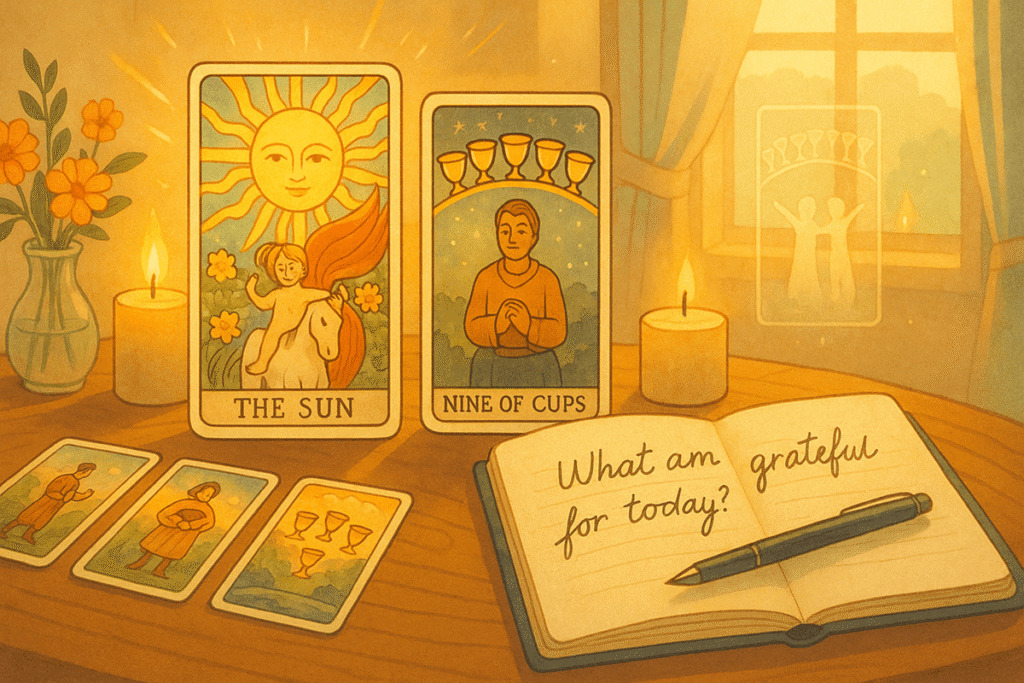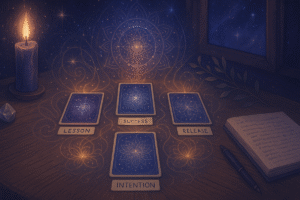Table of Contents
When I first started exploring tarot cards, I’ll admit I was drawn to the dramatic imagery and mysterious symbolism. The Death card, The Tower, The Devil. These seemed like the “real” tarot cards, the ones that held secrets and predictions. But somewhere along my journey, I discovered something perhaps more transformative than any future-telling spread: using tarot as a gratitude practice.
There’s something uniquely powerful about combining the visual richness of tarot with intentional appreciation. Maybe it’s the way cards can shift our perspective on everyday moments, or how they invite us to pause and really consider what’s present in our lives. Whatever the mechanism, I’ve found that tarot offers an unexpectedly gentle path toward cultivating genuine gratitude.
Why Tarot Works as a Gratitude Tool
Traditional gratitude practices often ask us to simply list what we’re thankful for. While this can be helpful, it sometimes feels mechanical or repetitive. How many times can you write “my family” or “my health” before the words lose their meaning?
Tarot cards function differently. They act as visual prompts that can illuminate aspects of our lives we might otherwise overlook. The imagery speaks to our subconscious in ways that direct questioning might not reach. A card like the Three of Pentacles might draw your attention to collaborative relationships you’ve been taking for granted. The Ace of Cups could highlight emotional abundance you hadn’t fully acknowledged.
I think what makes this approach particularly effective is how it removes the pressure to feel grateful “correctly.” Instead of forcing appreciation, the cards simply ask: what do you notice? What draws your attention? What feels significant right now? From there, gratitude often emerges naturally.
The process also engages multiple senses and learning styles. Visual learners connect with the artwork, while those who prefer reflection can dive deep into symbolic meanings. There’s something for everyone, which perhaps explains why this practice has resonated with so many people I’ve shared it with.
The Daily Gratitude Draw
The simplest way to begin incorporating tarot into your gratitude practice is through a daily single-card draw. Each morning, or whenever feels right for your schedule, shuffle your deck while holding this question in mind: “What can I appreciate in my life today?”
Draw one card and spend a few minutes simply looking at it. What do you notice first? What emotions does the imagery evoke? Don’t worry about traditional card meanings if you’re just starting out. Trust your intuitive response to what you see.
Let’s say you draw the Two of Cups. Rather than immediately thinking “this represents partnership,” you might notice the way the figures are looking at each other with genuine attention. This could prompt reflection on moments of real connection in your own life. Maybe it’s the barista who remembers your coffee order, or the way your pet greets you at the door. These small interactions, viewed through the lens of the card, suddenly seem worthy of appreciation.
Or perhaps you pull the Five of Pentacles, traditionally considered a more challenging card. Instead of focusing on lack or hardship, you might find yourself noticing what support systems exist in your life. The stained glass window in the card’s imagery could remind you of the shelter you have, both literally and metaphorically.
I’ve been surprised by how often seemingly difficult cards have led to profound gratitude insights. There’s something about approaching them with appreciation rather than fear that transforms their message entirely.
Working with Specific Cards for Gratitude Focus
While any card can serve as a gratitude prompt, certain cards naturally lend themselves to appreciation practices. I’ve found myself returning to a few particular cards when I want to cultivate specific types of gratitude.
The Sun practically radiates joy and vitality. When this card appears in a gratitude context, I often find myself appreciating simple pleasures. Warm sunlight through a window, a child’s laughter, the satisfaction of completing a task. The Sun reminds us that happiness often exists in uncomplicated moments.
The Nine of Cups has earned its nickname as the “wish card,” but I prefer to see it as the “contentment card.” The figure sits with obvious satisfaction, surrounded by symbols of fulfillment. This card invites reflection on what’s already working in your life. What wishes have already been granted? What dreams have quietly manifested?
The Ten of Cups speaks to emotional fulfillment and harmonious relationships. It’s not necessarily about having a perfect family or romantic situation, but rather about recognizing the love that does exist in your life, whatever form it takes. Sometimes this card helps me appreciate the complex beauty of imperfect relationships.
The Star offers a different flavor of gratitude focused on hope and possibility. When I work with this card, I often find myself grateful for second chances, for the ability to heal, for dreams that continue to inspire me even when they haven’t yet manifested.
These cards aren’t magic talismans that force gratitude. Rather, they serve as gentle invitations to notice what’s already present and worthy of appreciation in your life.
Creating a Gratitude Journaling Practice
Perhaps the most transformative way I’ve found to combine tarot with gratitude is through journaling. This practice takes the daily draw a step further, creating space for deeper reflection and more sustained appreciation.
Start by drawing a card with the same question: “What can I appreciate today?” But instead of just reflecting silently, write about your response. Begin with what you notice about the card itself. What catches your eye? What feelings arise? Then let your thoughts flow naturally from there.
I remember one morning when I drew the Hermit card. My initial reaction was disappointment; I was hoping for something more obviously positive. But as I began writing, I found myself appreciating my ability to be alone without being lonely. The Hermit’s lantern reminded me of the inner wisdom I’ve developed through various challenges. What started as a potentially negative card became a profound appreciation for my own growth and resilience.
The journaling process often reveals connections and patterns that aren’t immediately obvious. You might notice that you frequently draw cards related to creativity when you’re feeling particularly grateful, or that earth suit cards appear when you’re appreciating practical abundance in your life.
Don’t worry about writing perfectly or producing profound insights every day. Some entries might be just a few sentences. Others might turn into pages of reflection. The key is consistency and openness to whatever arises.
Seasonal and Themed Gratitude Spreads
Once you’re comfortable with single-card draws, you might enjoy exploring more complex gratitude spreads. These can be particularly meaningful during times of transition or when you want to take a broader look at appreciation in your life.
A simple three-card spread might explore: What am I grateful for from my past? What do I appreciate in my present? What future possibility fills me with gratitude? This creates a timeline of appreciation that can be surprisingly comprehensive.
During different seasons, you might adjust your approach. Autumn naturally lends itself to harvest gratitude, while spring might focus on growth and renewal. Winter could emphasize the appreciation of rest and reflection, while summer celebrates abundance and activity.
I’ve also found themed months helpful. Perhaps October becomes a month of appreciating relationships, with each daily draw focused on connection and community. December might center on gratitude for lessons learned throughout the year.
The beauty of creating your own spreads is that they can evolve with your needs and interests. There’s no right or wrong way to structure these practices.
Integrating Gratitude Tarot into Daily Life
The most sustainable gratitude practices are those that integrate naturally into your existing routines. You don’t need to create an elaborate ritual or set aside large blocks of time. Sometimes the most powerful moments of appreciation come through simple, brief encounters with the cards.
Keep a deck near your coffee maker and draw a card while your morning brew steeps. Pull a card before bed and let it guide a few minutes of grateful reflection. Use your phone’s camera to capture cards that particularly resonate with you, creating a visual gratitude journal you can revisit.
I’ve found that gratitude tarot works especially well during challenging periods. When life feels overwhelming or difficult, the cards can help redirect attention toward what’s still working, what support still exists, what beauty persists even in hard times.
This isn’t about forced positivity or denying real problems. Rather, it’s about maintaining a balanced perspective that includes appreciation alongside whatever challenges you’re facing.
The goal isn’t to become perpetually grateful or to never feel negative emotions. It’s simply to create more space for appreciation in your daily experience, and to develop a practice that can support you through all of life’s ups and downs.
Tarot, at its heart, is about perspective and possibility. When we bring these qualities to gratitude practice, something beautiful emerges: a sustainable way of noticing and appreciating the richness that already exists in our lives, one card at a time.
Frequently Asked Questions
Do I need to know traditional tarot card meanings to practice gratitude with tarot?
Not at all. The gratitude practice works beautifully whether you’re a complete beginner or experienced reader. You can respond to what you see in the imagery and how it makes you feel, rather than relying on memorized meanings. Your intuitive connection to the cards often reveals more meaningful gratitude insights than traditional interpretations would.
Can I use any tarot deck for a gratitude practice?
Yes, any tarot deck will work for gratitude practice. Some people prefer decks with uplifting imagery, but even decks with darker aesthetics can prompt meaningful appreciation when approached with a gratitude mindset. Choose a deck whose artwork speaks to you personally, as you’ll be spending time looking at the cards closely each day.
What if I draw a traditionally “negative” card like The Tower or Five of Pentacles during my gratitude practice?
This is actually one of the most powerful aspects of gratitude tarot. Challenging cards often lead to unexpected appreciation when you shift your perspective. The Tower might help you notice the stability you do have, while the Five of Pentacles could draw attention to your support systems. The practice invites you to find something to appreciate regardless of which card appears.
How long should I spend on my daily gratitude draw?
There’s no set timeframe. Some days you might spend just two or three minutes noticing what the card brings up, while other days you might journal for twenty minutes. The key is consistency rather than duration. Even a brief daily practice of pulling one card and acknowledging a single point of gratitude can create meaningful shifts over time.







